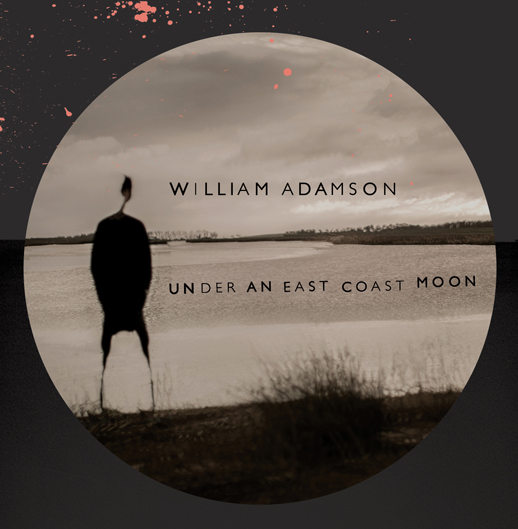A record by William Adamson. Released today on Brownswood Recordings.
A review by Kevin Pearce.
Ghosts Can’t Swim
Under an East Coast Moon by William Adamson is a remarkable record, an unexpected conceptual work, set in and about Suffolk. There is a certain Sebaldry to proceedings, perhaps. The writings and wanderings of W.G. Sebald and the startling seaboard of eastern England have, after all, inspired numerous works of art, but they can seem too concerned with reverence and ambience. What about the people and the stories? This record, however, throbs with tales, tall ones and folksongs, outside the lore, though it’s hard to tell what’s been handed down and what’s simply made up.
William Adamson plays tricks with time and memory. It’s all allusions and illusions, yarns spun like cobwebs caught on bracken, heard in the Flatlands’ fogs, carried on the wind across heaths and grassy expanses, distorted by village intrigue, echoing in old churches, floating like driftwood, the remains of secrets swallowed by the sea. The listener is whisked back and forth through the ages, regaled with vivid verses about the Puritans’ Iconoclast General William Dowsing and his deeds of desecration in the diocese, on to 1795 and Margaret Catchpole riding a stolen horse to her lost lover in London, on to the Great Storm of 15 October 1987 and its trail of destruction. There are fables about poachers and scientists, and maybe Laurence Edwards’ giant bronze statues of Anglo-Saxon Creek Men are brought to life for one last battle. The record dares you to make connections and links that may not even be there. “But what do I know?”
William Adamson is a new identity assumed by Rob Gallagher with his production partner Dill Harris. These gentlemen have previous, pedigree, form, call it what you will. Rob has appeared before us, as Galliano and Earl Zinger, a poet and singer. A seer? Well, a keen observer, at least. Dill is better known as Demus, a studio alchemist, part of the technical team behind the Young Disciples’ world changing Roads to Freedom LP. Together Rob and Demus have recorded as Two Banks of Four, making some of the loveliest LPs of the current millennium, presenting us with city sketches and street lullabies. Now they’re traipsing up and down the secret pathways of Suffolk.
Suffolk? But these chaps are surely the archetypal Londoners? Rob has, after all, written some of the great London songs, capturing a real sense of place and life as it is lived: Galliano’s Roofing Tiles, which is so beautifully melancholic and tender, with Rob sat by the canal-side wondering, and Earl Zinger’s Saturday Morning Rush, which is incredibly sharp and funny, a snapshot packed with detail and incident as our hero tears round Soho’s record shops in search of a new Skitz 12”. So what are these city watchers doing in rural Suffolk? Well, Londoners they may be, but Demus has it seems had a lifelong connection to the east Suffolk coastline and its history. And for a long time his studio was in an old stable in the marshlands close to the home of poet and Sebald’s friend/translator Michael Hamburger. This is where Two Banks of Four made their last LP, and Under an East Coast Moon was conceived and recorded there.
Musically, this wonderful LP suggests dog day afternoons, loafing, listening to Dr John, John Martyn, Tom Waits, Terry Callier, Terry Reid’s River, then switching to weather-beaten dub and blues in the night after a long walk in the light of a full moon. That may cause an eyebrow or two to rise, for the pair’s Two Banks of Four oeuvre seemed to ring with the bells of (Charles) Stepney, spiritual jazz meets Our Favourite Shop, all celestial charity-shop symphonies. But then again in the late ‘60s among Charles Stepney’s Chess moves were pioneering productions of experimental electric blues LPs by Howlin’ Wolf and Muddy Waters, which is a good place to start for William Adamson.
The record’s rather like a game of two halves: in the opening skirmishes all involved go for the direct approach, with gnarled, bark-like Beefheart buried broken bottleneck Sure ‘Nuff boogie, the Magic Band burning up the scrub, setting the heather on fire, because sometimes you have to howl like a wolf to be heard. Then in a tactical switch it’s more like the lost recording of another John Martyn Live At Leeds show, this time with Lee Perry doing the sound mix, cackling behind the desk, urging John Stephens and Danny Thompson to perform wilder acts of live voodooism, with that old boy from the pub next door sitting in with wheezing accordion on Scratch’s say-so. What’s that? Too far-fetched? Ah, but where all this takes place, it’s in-Sebaldy-nation, and we can tell any old stories there.
When considering Rob Gallagher’s credentials as a spinner of yarns, William Adamson’s Below Sea Level makes a strong case. It’s a tale about a scientist from the old Sizewell nuclear plant, who takes to listening to the sea at night, on the beach at Dunwich perhaps or nearby, attempting to crack the code. It’s narrated by Rob in the careworn tone familiar to anyone enchanted by Koop’s Beyond The Son, with creaking cranky accompaniment, and you could write a whole book about what happens next, who wanted to get their hands on the knowledge the old boffin had acquired, and so on.
Then onto the frantic finale, into injury time, the song Rings of Saturn, the guys going hell for leather, caught on a hidden camera running – from what? The title’s explicitly Sebaldic, familiar, but it is still tempting to write Rings Around Saturn, as in the Photek track. And that’s curious. It came out at the same time as the German original of W.G.’s graceful book, a few years before the English edition was published. Photek has Suffolk connections. Aha. So were Sebald and Photek gazing at the same sky in August 1992, watching the same clouds? And where does Photek’s source, Pharoah Sanders’ Astral Travelling, fit into all this? Well, some might say that the spirit of Cecil McBee’s bass is at work in the eye of this storm from the east, but no-one’s really letting on.
One of the charms of the book Rings of Saturn is the writer’s references to friends and quaint acquaintances consumed by eccentric passions and projects, consumed by exhaustive and inordinately detailed studies and works. There is something of that about this William Adamson work: a lot’s gone into its preparation, and it shows. The record will come with some lovely artwork and a great set of on-location photos by Chris Friel. Then there is the website which features an interactive map of their Suffolk locale, stretching down to Orford in the south, Southwold in the north and inland for twenty odd miles to Laxfield. For the more curious, prepared to use their wits, clues lead to another site, an ‘alternative version of the topographical trail’, with radical, astonishing dub treatments of the William Adamson tracks which sound like the possessed producer set about the mixing console with metallic implements: ah, then that’d be (Shaka) Demus with pliers in hand. Hopefully these versions will appear on vinyl, if not we should take to the barricades: for, as the Dunwich duppy knows, dub is the answer to everything. Ghosts can’t swim but they sure can dance.
Under an East Coast Moon by William Adamson is out today on Brownswood Recordings. More fun can be had by exploring underaneastcoastmoon.com
Buy it here.

